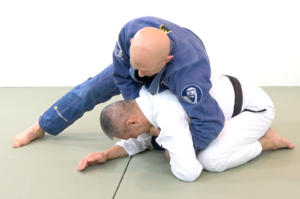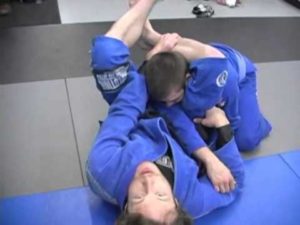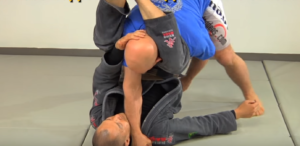The crucifix is a powerful and deadly submission position in Brazilian Jiu Jitsu. It can be used as a great way to attack an opponent while he is in turtle. It also can be another way of attacking your opponent from the back position.
One of the the reasons why fighters love this position is because it gives them dominant control over their opponent. Once you’re placed in the crucifix it’s a certainty that you can’t escape, the fight is as good as done.
It’s hard to reverse or fight back when you’re on the ground and both your hands are pinned and locked up. You can execute multiple submissions from the crucifix position but first let’s take a look at some ways to set up or enter into the position.
Crucifix Entry From Turtle Position
In the simplest terms possible, the goal is to try to pin one side of the opponent’s body with your legs and hips and control the opposing side of their body with your arms and upper body.
Once the opponent is controlled, you can begin working the various submissions options like chokes and arm attacks.
A basic entry point into the crucifix is from the turtle position. To do this your opponent needs to be on their knees.
Whether your opponent shot for a takedown and you sprawled onto his back, pinning him down to his knees. Or you two were both already on the ground, the objective is to do the crucifix choke from the turtle position.
Once there (and we’ll do this from your left hand side first) you want to take your knee that’s closest to his hip, and slide it in between his elbow and lat, while simultaneously hooking your left arm under his shoulder, and hooking your right arm over his shoulder.
You then want to take your arm that’s hooked underneath his shoulder, and grab onto the wrist of your arm that is hooked over his shoulder. This grip is called a seat belt.
Once locked in your next move is to take your left shin and slide his forearm outward. As soon as you see his forearm you want to take your free foot, in this case it would be your right foot, and step on it.

Be sure to make sure the heel of your foot is as close to the shin of your left leg as possible. This will clamp down your opponents forearm as tight as possible.
Now that you have your opponent tied up and under your full control, you want to lower your right leg and roll onto your right side. Remember to keep your opponent tightly into you. You want a tight embrace.
Kick your legs through and tie his forearm up with them. This will put you in the crucifix position. In this position your opponent will have a free hand.
You can use your free left hand to grab onto his, while your right arm slides under his throat, then you pull back towards the ground to complete the submission.
Keep in mind that sometimes you won’t be able to grab his free hand due to him resisting and fighting you off. that is okay. A one arm rear naked choke can still work. Grabbing onto his free hand is not need.
The second submission is an armbar using your legs. Once in the crucifix position you can pull back your legs towards you and to the ground. That pull back will stretch out your opponents arm and shoulder and cause him to tap out.
This is to be uses if you are not able to tap your opponent out using the rear naked choke. Or if your skilled enough you can use both at the same time!
Crucifix Choke From Top Side Control
Another way that you can execute the crucifix choke is from top side control. So you start off with being in side control and need to maneuver your way into the right position. Let’s imagine that you’re in side control laying on your right side.
What you want to do is place an underhook on the far arm of your opponent. The next step is to slide your hips towards your opponents head, and place their inside arm between your legs.
Once the arms are secured you’re going to figure-four the inside arm and lock it in place. To execute the submission you need to turn up to your left side to the point where your stomach is touching the top of your opponents head.
You want to do this with momentum and force, yanking your opponent’s shoulder will help execute a solid crucifix position.
Lapel Choke From The Crucifix Position
So to execute the lapel choke from crucifix you simply have to find your entry points. For this example let’s go back to using the entry point from the turtle position.
Reach over your opponents back with your arm and position and underhook grabbing onto his wrist. This is wrist control so that there’s less movement from your opponent’s arm to fend you off.
Then you want to slide your knee in between your opponent’s elbow and knee. Just like the previous example I spoke about above.
At the same time you want to take your free hand and grab the opponent’s label to gain collar control. Again, control makes it harder for your opponent to resist and fend you off.
Having more control over your opponent allows you to dominate them more, and gain enough position to submit them. The more you’re able to constraint their movement, the better. Now roll onto your back.
When you roll onto you back be sure to still maintain wrist and collar control. When you reach for the lapel insert your thumb into the collar for a deep grip.
Then straighten your arm up bringing it back, while the thumb under the neck gripping the lapel moves forward. This should execute the choke and have your opponent tap out.


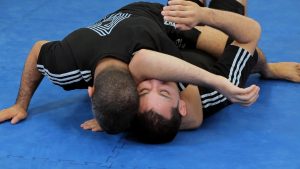 Arm Triangle Choke From Forearm Set-up
Arm Triangle Choke From Forearm Set-up
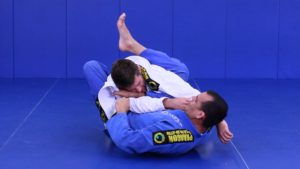

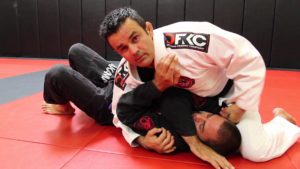
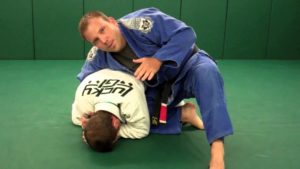 In Turtle position as you know, your opponent is on his knees hunched forward sometimes leaned over on his forehead, forearms or hands.
In Turtle position as you know, your opponent is on his knees hunched forward sometimes leaned over on his forehead, forearms or hands.